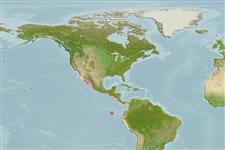Environment: milieu / climate zone / profondeur / distribution range
Écologie
marin pelagic-neritic. Tropical; 34°N - 17°S, 121°W - 71°W
Eastern Pacific: Southern California, Gulf of California and the western coast of Baja California, Mexico to Peru, including many offshore islands.
Taille / Poids / Âge
Maturité: Lm ? range ? - ? cm
Max length : 106 cm TL mâle / non sexé; (Ref. 55763); common length : 20.0 cm TL mâle / non sexé; (Ref. 9301)
Description synthétique
Clés d'identification | Morphologie | Morphométrie
Épines dorsales (Total) : 0; Rayons mous dorsaux (Total) : 17 - 20; Épines anales: 0; Rayons mous anaux: 16 - 19; Vertèbres: 75 - 76. Rows of spinules in skin easily seen but individual spinules difficult to discern. Color in life orange to red above, with brownish and black blotches. Lighter below. Dorsal and anal fins with orange bases. Caudal filament dusky (Ref. 9826). Branchiostegal rays: 5 (Ref. 36710).
Body shape (shape guide): elongated; Cross section: flattened.
Adults occur at depths greater than 30 m, along continental and insular margins (Ref. 36710), over rocky substrates (Ref. 37955). Feeds on small fishes (Ref. 37955). Marketed fresh, salted or dried and smoked but more frequently processed into fishmeal (Ref. 9301).
Life cycle and mating behavior
Maturité | Reproduction | Frai | Œufs | Fécondité | Larves
Fritzsche, R.A. and M. Schneider, 1995. Fistulariidae. Cornetas. p. 1104-1105. In W. Fischer, F. Krupp, W. Schneider, C. Sommer, K.E. Carpenter and V. Niem (eds.) Guia FAO para Identification de Especies para lo Fines de la Pesca. Pacifico Centro-Oriental. 3 Vols. FAO, Rome. (Ref. 9301)
Statut dans la liste rouge de l'IUCN (Ref. 130435: Version 2025-1)
Menace pour l'homme
Harmless
Utilisations par l'homme
Pêcheries: pêcheries vivrières
Outils
Articles particuliers
Télécharger en XML
Sources Internet
Estimates based on models
Preferred temperature (Réf.
123201): 20.6 - 28.4, mean 25.6 °C (based on 66 cells).
Phylogenetic diversity index (Réf.
82804): PD
50 = 0.6250 [Uniqueness, from 0.5 = low to 2.0 = high].
Bayesian length-weight: a=0.00112 (0.00059 - 0.00213), b=2.86 (2.69 - 3.03), in cm total length, based on LWR estimates for this species & (Sub)family-body (Ref.
93245).
Niveau trophique (Réf.
69278): 4.5 ±0.80 se; based on food items.
Résilience (Réf.
120179): Haut, temps minimum de doublement de population inférieur à 15 mois (Preliminary K or Fecundity.).
Prior r = 0.54, 95% CL = 0.36 - 0.81, Based on 2 data-limited stock assessments.
Fishing Vulnerability (Ref.
59153): High vulnerability (64 of 100).
🛈
Nutrients (Ref.
124155): Calcium = 102 [58, 252] mg/100g; Iron = 1.61 [0.88, 2.91] mg/100g; Protein = 18.1 [16.9, 19.4] %; Omega3 = 0.197 [0.100, 0.415] g/100g; Selenium = 109 [48, 246] μg/100g; VitaminA = 9.97 [3.26, 29.30] μg/100g; Zinc = 0.838 [0.554, 1.279] mg/100g (wet weight);
